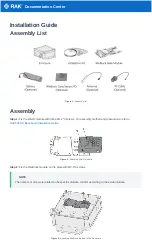
4
1. Installing your Spider 6
1.1. Positioning the Spider 6
Correct positioning of the Spider’s antenna is critical in achieving effective performance
from the Spidertracks system as a whole. When installing any Spider product that has the
antenna integrated within the device, particular attention is required. In this case the Spider
should be mounted up on top of the instrument panel in the aircraft, as far forward under the
glare shield as possible to maximise visibility with the sky, and free from any obstructions.
In order to function nominally, the Spider is required to receive GPS signal and then transmit
that information, along with other flight data, to the Iridium satellite network. The GPS
antenna is able to receive GPS information at any angle, as long as it is not obstructed by
metallic material, such as the centre windshield pillar, however, the Iridium antenna must
have an unobstructed, horizon-horizon view of the sky in all directions to function nominally
(Figure1). Obstructions consist of any metallic or carbon composite object, but also
electrically heated windshield filaments that act as an RF shield whether they are turned on
or not (Faraday Cage effect). The Spider is able to transmit through glass, fibre glass, or
plastic. Please see installation examples on our support website.
NB: If you are attempting to fit a Spider with integrated antennae into an aircraft with
electrically heated windshields please stop and contact your distributor for advice.
Figure 1: Visibility of the sky requirements for an Iridium transmitting product
Summary of Contents for Spider 3
Page 12: ...11 Appendix...
Page 24: ...23 D Wiring Diagram Power Lead...






































